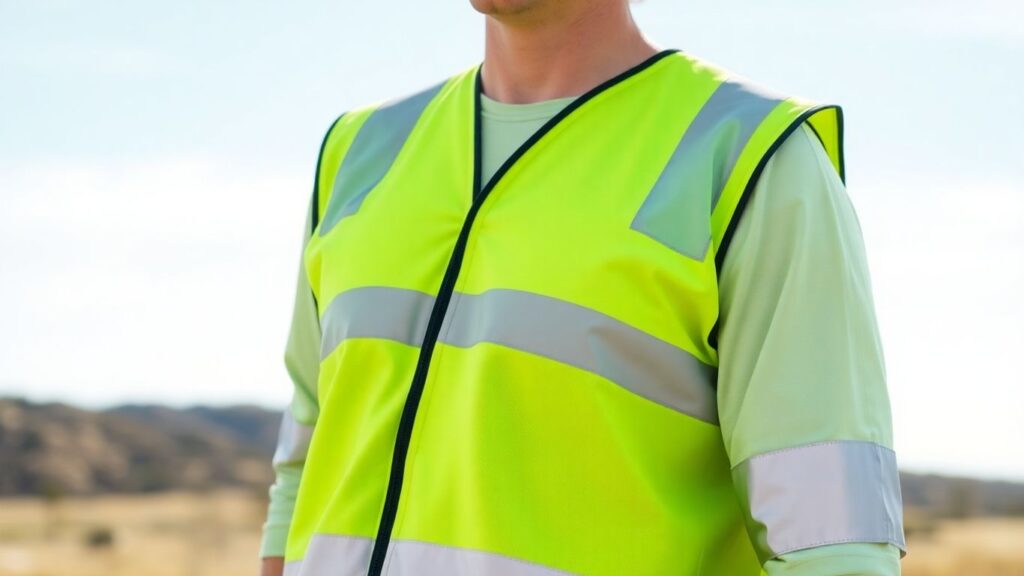Working in Australia means dealing with a lot of sun, dust, and sometimes, fast-moving traffic. Whether you’re on a construction site, directing traffic, or just visiting a busy worksite, making sure people can see you is a big deal. That’s where a good high vis vest australia comes in. It’s not just about looking the part; it’s about staying safe and compliant with the rules. We’ll break down what you need to know to pick the right one, so you can get back to your job without worrying about being missed.
Key Takeaways
- Always check that your high vis vest australia meets the AS/NZS 4602.1:2011 standard, which is the main rule for visibility in Australia.
- Understand the difference between Class D (day), Class N (night), and Class D/N (dual use) vests to pick the right one for your specific work environment.
- Consider the fabric and how breathable it is, especially if you’re working in Australia’s warmer climates. A comfortable vest is more likely to be worn correctly.
- Make sure the vest fits properly over your work clothes and doesn’t restrict your movement. Adjustable sides can really help with this.
- Don’t just go for the cheapest option; quality matters. A well-made high vis vest australia will last longer and provide better protection than a flimsy, low-cost alternative.
Understanding High Vis Vest Australia Standards
Right, let’s get down to the nitty-gritty of what makes a high-vis vest actually work here in Australia. It’s not just about slapping some bright fabric on and calling it a day. There are actual standards to follow, and they’re there for a good reason – keeping you seen and safe.
AS/NZS 4602.1:2011: The Foundation
This is the big one, the main standard that governs high-visibility clothing for people working in situations where they need to be seen. Think busy roads, construction sites with lots of machinery, or anywhere there’s a risk of not being spotted by vehicles or equipment. This standard is your go-to for making sure the vest you choose is actually designed for safety in high-risk Australian environments. It covers how the garments should be made and how well they should perform.
Classifications: Day, Night, and Dual Use
High-vis vests aren’t one-size-fits-all when it comes to visibility. The AS/NZS 4602.1:2011 standard breaks them down into different classes based on when you’ll be wearing them:
- Class D (Daytime): These use fluorescent colours, like bright yellow or orange, to stand out in natural daylight. Perfect for outdoor work when the sun’s up.
- Class N (Night-time): These rely on retroreflective tape. This tape bounces light back towards the source, like headlights, making you visible in the dark. Think road crews working late or early.
- Class D/N (Day/Night): The most versatile option. These combine both fluorescent fabric for daytime and reflective tape for nighttime. If your work shifts change or you’re in environments with varying light conditions, this is usually the way to go.
Material Standards: AS/NZS 1906.4:2010
While AS/NZS 4602.1:2011 tells you what kind of vest you need, AS/NZS 1906.4:2010 gets into the specifics of the materials used. This standard focuses on the colours and retroreflective materials themselves. It dictates things like:
- Colourfastness: How well the fluorescent colours hold up against fading from sunlight and washing.
- Retroreflectivity: How effectively the tape reflects light back. This is measured under specific conditions to ensure it performs as expected.
- Material Durability: How the fabric and tape will hold up to general wear and tear.
Basically, this standard ensures the bright bits and the shiny bits on your vest are up to scratch and will actually do their job when you need them to. It’s all about making sure the materials meet the performance requirements for safety garments in Australia.
Choosing Your High Vis Vest: Key Considerations

So, you’ve got the lowdown on the standards, which is great. But picking the actual vest? That’s where things can get a bit tricky if you’re not sure what to look for. It’s not just about grabbing the brightest thing off the shelf, you know. You’ve got to think about where you’ll be wearing it, what you’ll be doing, and, let’s be honest, how comfortable it’s going to be.
Visibility Class for Your Work Environment
This is probably the most important bit. The standard AS/NZS 4602.1:2011 breaks down vests into classes based on when and where you need to be seen. Get this wrong, and you’re not as safe as you think.
- Class D (Daytime): Think bright fluorescent colours like yellow or orange. These are for when you’ve got plenty of natural light, like working in a construction yard during the day or loading trucks in broad daylight. They stand out against most backgrounds.
- Class N (Night-time): This is all about reflective tape. These vests use special materials that bounce light back, so headlights or work lights make you pop. If you’re on a night shift, working near traffic after dark, or in any low-light situation, this is what you need.
- Class D/N (Dual Use): The best of both worlds, really. These combine fluorescent colours with reflective tape. They’re the most versatile and a good bet if your work hours change or you’re often moving between day and night conditions. They give you consistent visibility, no matter the light.
Choosing the right class isn’t just a suggestion; it’s about making sure you meet safety regulations and, more importantly, that you’re actually visible to others when it counts. A vest that’s not right for the conditions is basically just a coloured shirt.
Fabric and Breathability for Comfort
Working in Australia can mean some serious heat, so comfort is a big deal. A vest that makes you sweat buckets or restricts your movement isn’t going to get worn properly, and that defeats the whole purpose. Look for vests made from lightweight, breathable materials, especially if you’re doing physical work outdoors.
- Mesh Fabric: Great for airflow. If you’re in a hot climate or doing a lot of moving around, mesh vests let the breeze through, keeping you cooler.
- Solid Fabric: These can be more durable and might offer a bit more protection against snags or light rain. Some are designed with moisture-wicking properties, which is a nice bonus.
- Layering: Don’t forget you might need to wear this over other clothes, like a jumper in winter. Make sure there’s enough room and that the fabric doesn’t feel too stiff or heavy when layered.
Fit and Adjustability for Proper Wear
This one’s pretty straightforward but often overlooked. A vest that’s too tight will restrict your movement, and one that’s too loose can snag on things or just flap around, making it less effective. You want it to sit nicely over your work clothes without being a nuisance.
- Adjustable Sides: Many vests have Velcro tabs or elastic panels on the sides. These let you cinch the vest in for a snugger fit, especially if you’re wearing different layers underneath.
- Length: Make sure the vest isn’t too long that it gets in the way of your legs or any safety harnesses you might be wearing. It should cover your torso comfortably.
- Gender-Specific Options: Increasingly, you can find vests designed with women in mind. These often have a more tailored cut, which can make a big difference in comfort and how well they fit. It’s worth looking into if standard unisex sizes aren’t working for you.
Basically, if it doesn’t fit well, you’re less likely to wear it correctly, and that’s a safety risk in itself. Think about how it feels when you move – can you reach, bend, and lift without feeling restricted?
Industry-Specific High Vis Vest Requirements

Not all jobs are created equal when it comes to safety gear, and your high-vis vest is no different. What works for someone on a busy highway might be overkill, or not enough, for a warehouse worker. It’s all about matching the vest to the risks and the environment you’re in.
Construction and Road Work Needs
This is where you’ll often see the most robust vests. Think about it: you’re out in the elements, dealing with moving vehicles, heavy machinery, and all sorts of dust and grime. Visibility is absolutely key, both day and night, so you’ll want a vest that meets Class D/N standards to cover you around the clock. Durability is also a big one; these vests need to stand up to a fair bit of rough treatment. Look for tougher fabrics that can handle being snagged or rubbed against rough surfaces. Pockets for tools or a radio can be a handy bonus too.
Warehousing and Logistics Choices
Inside a warehouse or a busy distribution centre, the risks are a bit different. While you still need to be seen, especially around forklifts and moving stock, you might not need the same heavy-duty protection as outdoor construction. Lighter, more breathable vests are often the go-to here. Mesh panels can make a big difference in keeping you cool during long shifts, particularly in warmer Australian climates. Class D vests are usually sufficient for these indoor or lower-traffic environments.
Emergency Services and Transport Demands
For our ambos, ambos, firies, and transport workers, the stakes are often higher and the conditions more unpredictable. Visibility needs to be top-notch, 24/7, so Class D/N vests are pretty standard. But it’s not just about being seen; these roles can involve exposure to flames, water, or other hazards. That’s why you might see vests made from specialised materials like flame-retardant or water-resistant fabrics. Always double-check that any vest you’re considering meets the specific PPE standards set by your agency or organisation.
Choosing the right vest isn’t just about ticking a box; it’s about making sure you can do your job safely and comfortably. The wrong vest can be a distraction, or worse, a hazard itself. Always consider the specific demands of your role and workplace.
| Industry Sector | Typical Risk Level | Recommended Class | Key Features to Consider |
|---|---|---|---|
| Construction & Road Work | High | D/N | Durability, high visibility (day/night), tool pockets |
| Warehousing & Logistics | Medium | D | Breathability, lightweight, comfort for long shifts |
| Emergency Services | High | D/N | Specialised fabrics (FR/WR), high visibility, durability |
| Transport | Medium to High | D/N | High visibility, durability, comfort for extended wear |
Beyond the Basics: Enhancing Vest Functionality
So, you’ve got the standard high-vis vest sorted, but what else can you do to make sure you’re seen and safe? It’s not just about the colour and the basic reflective strips anymore. There are heaps of ways to tweak your safety gear to make it work better for you and your specific job.
Additional Safety Features
Think about what you do day-to-day. Do you need to carry a radio, a pen, or maybe some small tools? Look for vests with extra pockets. Some even have clear ID holders, which is handy if you’re on a site where you need to show your credentials regularly. For those working near flames or in wet conditions, you might want to check out vests made with fire-resistant or waterproof materials. These aren’t standard on every vest, but they can be a lifesaver in the right situation.
Alternative High Vis Apparel Options
Who says it has to be a vest? Sometimes, especially when it’s stinking hot or you’re doing a lot of physical work, a full vest can be a bit much. Safety sashes are a good shout. They’re basically reflective bands that go over your shoulders and around your waist, giving you that high-vis coverage without all the bulk. They let your body breathe a lot better. You can also get reflective armbands or ankle bands if you just need a bit of extra visibility on top of your regular work clothes. Just make sure whatever you choose still meets the Australian standards for visibility coverage.
Design Preferences and Team Identity
It’s not all about function, though. Sometimes, you want your gear to look a bit sharper or represent your team. You’ll see vests with different colour combos, like fluorescent yellow and orange with black panels at the bottom. This looks pretty good and also helps hide dirt, which is a bonus on dusty sites. There are even some hi-vis vests with camouflage patterns now, which is a bit different but still keeps you visible. Plus, having a consistent look for your team can make you stand out as a professional unit.
When you’re looking at extra features or different styles, always double-check that the core safety requirements are still met. A vest with loads of pockets is no good if the reflective tape is poorly placed or the fabric doesn’t meet the visibility standards. It’s about finding that balance between extra convenience and your fundamental safety.
Here are some things to think about when picking out those extras:
- Pockets: How many do you need, and what size? For pens, phones, radios, or small tools?
- Fastening: Zips offer a snug fit, Velcro is quick and easy, and snap buttons are tough. Think about what works best when you’re wearing gloves or in a hurry.
- Material: Beyond basic polyester, consider mesh for breathability in heat, or heavier fabrics for durability. Some are even water or fire-resistant.
- Fit: Especially for women, look for vests designed with a better fit. A vest that’s too loose or too tight isn’t just uncomfortable; it can actually reduce your visibility.
Common Pitfalls When Selecting Vests
Picking the right high-vis vest might seem straightforward, but there are a few traps people often fall into. It’s not just about grabbing the brightest thing off the shelf; there’s a bit more to it if you want to stay genuinely safe and compliant.
Ignoring Australian Safety Standards
This is a big one. You can’t just assume any old hi-vis vest will do. We need to make sure it meets the Australian standards, specifically AS/NZS 4602.1:2011. Imported gear might look the part, but it might not have the right type or placement of reflective tape, or the fabric might not hold up. Always check for that certification mark – it’s your assurance that the vest is built for our conditions and meets the legal requirements for visibility.
Selecting the Incorrect Visibility Class
So, you’ve got your vest, but is it the right class for your job? This is where things can get dicey. You’ve got Class D (Day), Class N (Night), and Class D/N (Dual Use). Using a vest that’s only good for daytime visibility when you’re working after dark is a recipe for disaster. Likewise, a Class N vest might not be bright enough in broad daylight. It’s all about matching the vest’s capabilities to the lighting conditions you’ll be working in. For example, road construction often needs Class D/N, while certain indoor warehouse roles might be fine with just Class D. Getting this wrong means you’re not as visible as you need to be.
Prioritising Price Over Quality
Look, we all like a bargain, right? But when it comes to safety gear, the cheapest option often ends up costing you more in the long run. A vest that’s super cheap might use lower-quality fluorescent fabric that fades fast, or the reflective tape might start peeling off after a few washes. This means your visibility drops, and you might not even realise it until it’s too late. Investing a bit more in a well-made vest from a reputable supplier, like those found at workwear and safety gear, means you’re getting something that will last longer and perform better, keeping you safe on the job.
Overlooking Fit and Comfort
This might sound minor, but it’s actually pretty important. If a vest is too tight, too loose, or just plain uncomfortable, people tend not to wear it properly, or sometimes, not at all. A vest that’s constantly riding up, twisting around, or restricting your movement isn’t doing its job. You need to be able to move freely, especially if you’re doing physical work. Plus, you need to be able to wear it over your other work clothes, like a jumper in winter, without it feeling like a straitjacket. Adjustable sides and breathable materials really make a difference here.
Stay Seen, Stay Safe
So, that’s the lowdown on hi-vis vests here in Australia. It’s not just about chucking on any old bright bit of fabric; there are actual rules and standards to follow, like AS/NZS 4602.1:2011, to make sure you’re properly seen. Whether you’re out on a busy road, in a dusty warehouse, or working the night shift, picking the right class of vest – D, N, or D/N – is a big deal. Don’t forget about how it fits, what it’s made of, and if it’s comfy enough to wear all day. A bit of thought into your hi-vis gear can make a world of difference to your safety. So, make sure you and your mates are kitted out properly. It’s a simple step that keeps everyone safer on the job.
Frequently Asked Questions
What’s the main rule for hi-vis vests in Australia?
The big rule in Australia is that your hi-vis vest needs to follow the AS/NZS 4602.1:2011 standard. This means it has to be made with the right colours and reflective bits to make sure you can be seen easily, especially when you’re working near moving cars or machines.
What do the ‘Class D’, ‘Class N’, and ‘Class D/N’ mean on vests?
These classes tell you when the vest works best. ‘Class D’ is for seeing during the day, using bright colours. ‘Class N’ is for seeing at night, using special tape that bounces back light from headlights. ‘Class D/N’ is the best of both worlds, working well in daylight and darkness.
Why is the fabric and how breathable it is important for a hi-vis vest?
It gets pretty warm here in Australia! If your vest is made of stuff that doesn’t let air through, you’ll get super hot and sweaty, especially if you’re doing hard work. Choosing a vest made from lighter, breathable material like mesh helps you stay comfortable and focused on your job.
Does the fit of my hi-vis vest really matter that much?
Absolutely! A vest that’s too tight will be uncomfortable and might rip, while one that’s too loose could get caught on things or just not be seen properly. It needs to fit comfortably over your normal work clothes so you can move freely and be clearly visible all over.
Are there special hi-vis vest rules for different jobs?
Yeah, there are! For example, if you’re working on a busy road or a construction site, you’ll probably need a vest that works day and night (Class D/N) because there are lots of moving vehicles. In a quiet warehouse, a vest just for daytime might be enough. It all depends on the risks of your specific job.
What’s a common mistake people make when buying hi-vis vests?
A really common mistake is not checking if the vest actually meets the Australian standards (AS/NZS 4602.1:2011). Some cheaper vests might look the part, but they might not be bright enough or have the right reflective tape, meaning they aren’t as safe as they should be. It’s better to spend a bit more on a quality, compliant vest.





